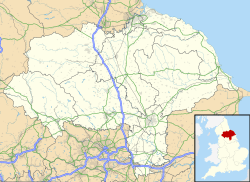Church of St Andrew, Finghall facts for kids
Quick facts for kids St Andrew's Church, Finghall |
|
|---|---|
| The Parish Church of St Andrew, Finghall | |

The Church of St Andrew, Finghall
|
|
| 54°18′24.2″N 1°42′30.5″W / 54.306722°N 1.708472°W | |
| OS grid reference | SE182897 |
| Location | Finghall |
| Country | England |
| Denomination | Church of England |
| Weekly attendance | 15 (average between 2006–2015) |
| History | |
| Status | Active |
| Dedication | St Andrew |
| Architecture | |
| Architectural type | Early English |
| Specifications | |
| Bells | 2 |
| Administration | |
| Parish | Finghall |
| Deanery | Wensley |
| Archdeaconry | Richmond and Craven |
| Diocese | Leeds |
The Parish Church of St Andrew, Finghall, is the parish church for the village of Finghall in North Yorkshire, England. The building is located on the site of a much earlier Anglo-Saxon church and has some remnants of that era incorporated into the building, though the present structure dates back to the 12th century. The church is nearer to the hamlet of Akebar than it is to Finghall, which is 0.5 miles (0.80 km) to the south, because the church was originally in a medieval village that was deserted when it was ravaged by plague. The building is now a grade II* listed structure and is still used for worship.
History
The Church of St Andrew, Finghall, was built in the Early English style in the late 12th century and is now grade II* listed. It has a tower to the west with a nave, chancel and a rare double bell holder (bell-cot) situated on the centre of the church roof. The roof is described as being very low, with one writer stating that "[it comes] nearly to the ground," and whilst one bell is undated, the other shows it to have been cast in 1620. Some elements are thought to be Anglo-Saxon in nature, including a blocked doorway into the nave dated to around 1140 and an Anglo-Saxon cross-head from the 9th century which is built into the chancel. The church was rebuilt in the 14th century and smaller additions were made in the 18th and 19th centuries with a complete restoration in 1904. Further restorations were undertaken in 1959 and 1964.
The most recent restoration was in the year 2000 when the commandment boards were restored. The commandment boards were instituted by Queen Elizabeth I in the 16th century, but Finghall didn't get theirs until the middle of the 18th century.
In 1801, the Reverend Luke Yarker employed several people as musicians and singers in the church. The musicians were supplanted in 1865 by a harmonium, which was replaced in 1894 by an organ that had previously been in Constable Burton Hall.
The church is sited next to Leeming Beck (named Bedale Beck further down the valley) and was formerly in an Anglo-Saxon village. As with other Deserted Medieval Villages (DMVs), the belief was that the plague was a water-borne infection and so the villagers moved to the present day site of Finghall village which lies 0.5 miles (0.80 km) to the south of the church. This had led historians to label such places of worship as 'Plague Churches'.
The church was patronised by the Fitzhugh and the Wyvill families and the site is believed to have been the meeting of a church Synod in the year 768. Other notable families were patrons of the church and were afforded the right of advowson. The Scrope family lost this right in 1415 when their lands were confiscated (including Finghall church) by the crown on account of Henry Scrope's involvement in the 1415 plot to murder King Henry V. Scrope was executed at Southampton for this.
Two of the graves in the churchyard belong to military airmen. One is of a Royal Flying Corps airman who was the only son of the vicar at Finghall at that time. E.H.G. Sharples died in January 1918 in a training accident. The other grave is from the Second World War and holds the remains of Flying Officer N.J.M. Barry.
The church is in a Benefice with five other churches; St Gregory's (Crakehall), St Mary's (Hornby), St Michael's (Spennithorne), St Oswald's (Hauxwell), and St Patrick's (Patrick Brompton). Together, these six churches are collectively known as Lower Wensleydale.
Vicars at Finghall
Below is a list of rectors from Finghall. At some point in the late twentieth century, the incumbent at Patrick Brompton became the vicar for the extended parish.
- John de Segbrook - 1368
- Will Lyllforth
- Will Foxholes - 1420
- Roger Parker - 1457
- John Taylor
- Peter Conder
- William Typping - 1541
- Lacell Routh - 1572
- Reginald Lancaster - 1587
- Matthew Levett - 1622
- Henry Paget
- Robert Smith - 1665
- Henry Raper - 1710
- Thomas Nelson - 1735
- Luke Yarker - 1776
- Nicholas Bourne - 1803
- Edward Wyvill - 1820
- George Henry Ray - 1869
- Henry Milner Sharples - 1893
- Walter Hawkesworth Fawkes - 1920 (held in plurality with the parish of East Hauxwell)
- John William de la Poer Beresford-Peirse - 1944
- Demetrius Thomas Reynolds Carlin - 1947
- Joseph Nicholls Jory - 1954
- Benjamin William Crawford - 1971
- William Frederick Greatham - 1975
- Raymond Joseph Pearson - 1982
- David James Christie - 1995
- William John Hulse - 2002
- Bryan Stanley Dixon - 2012 (Held in plurality with the parishes of Patrick Brompton, Hornby & Crakehall)
- Robin David Christopher Lawton - 2017


